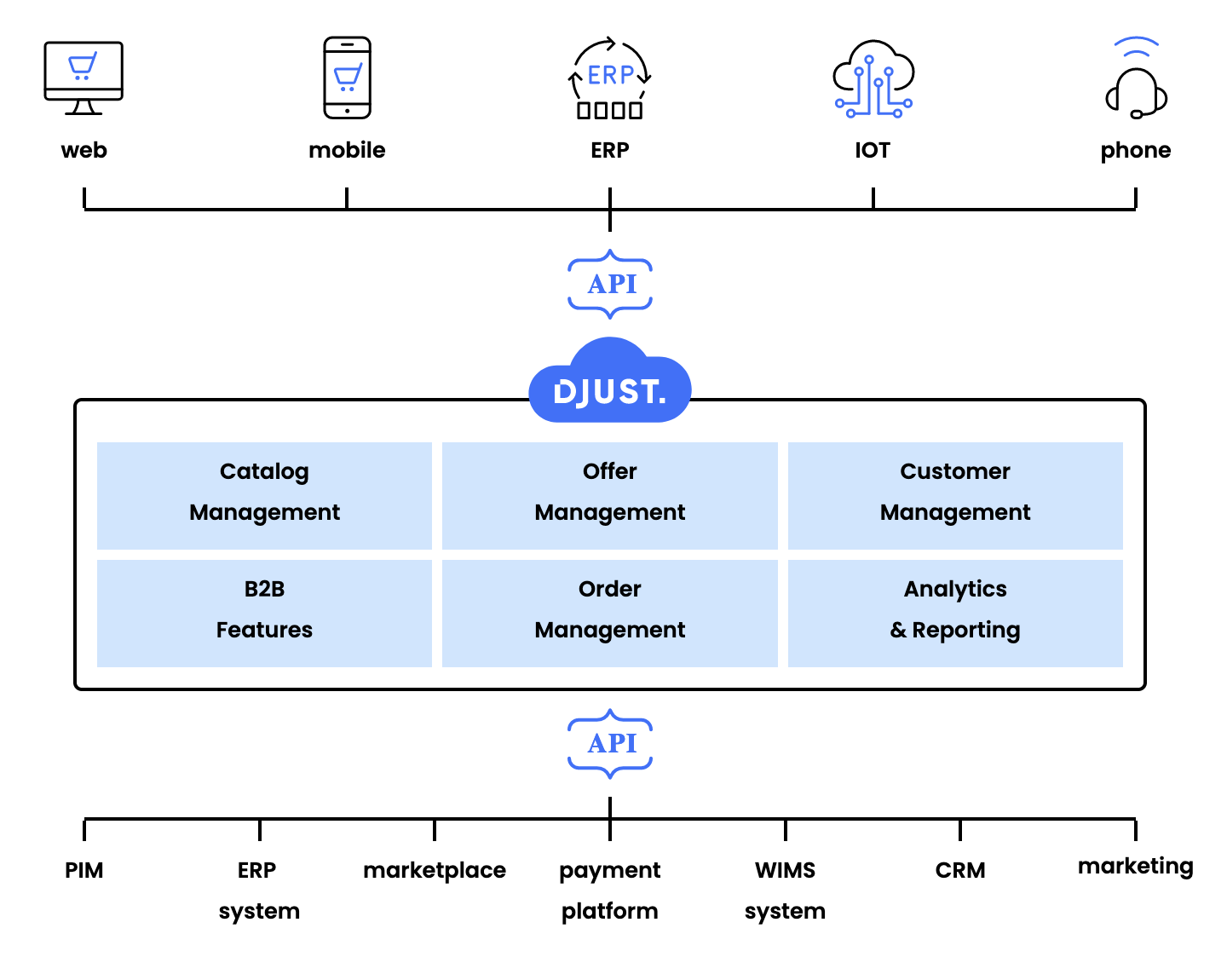

In an era where digital transformation dictates market dynamics, B2B composable commerce is rapidly becoming a cornerstone for corporate buyers.
Nearly two-thirds (65%) of B2B companies now offer robust eCommerce capabilities, according to a recent report by McKinsey—a significant leap from 53% in early 2021. This surge, fueled by a surge in the adoption of digital solutions since 2020, signifies a real and significant paradigm shift. In fact, eCommerce drives more than 18% of all revenue for the average B2B company today.
This trend underscores the urgency for businesses to adapt their strategies and embrace the evolving landscape of B2B composable commerce.
Understanding composable commerce
In a nutshell, composable commerce refers to a modular approach to B2B eCommerce. Businesses pick and choose different components and solutions based on their needs.
This might include, for example, the customer-facing platform itself, a payment gateway, an inventory management system, customer relationship management (CRM) software, a module for analytics and reporting, and a personalization engine.
This is in contrast to more rigid, monolithic approaches, where businesses are beholden to a single solution. And wherever it doesn’t meet their needs, they must engage in all kinds of costly operational acrobatics to arrive at a work-around.
Composable commerce leverages four key concepts to help businesses accelerate and benefit from their adoption of eCommerce:
- Modularity: Businesses can select individual components or services, such as inventory management, payment processing, or customer relationship management (CRM), to create a tailored eCommerce solution.
- Flexibility: A composable architecture allows for swift adaptation to market changes and evolving business needs, ensuring scalability.
- Business-centricity: Solutions are designed around unique business requirements and goals. This allows businesses to escape the limitations of traditional, monolithic platforms that lock them into proprietary solutions with little flexibility...
- Open ecosystem: Integrations exist with a broad range of third-party systems via APIs, making it highly customizable and interoperable with existing processes and systems.

Composable commerce architecture
Composable commerce empowers B2B organizations to build a more agile, customer-focused, and scalable eCommerce ecosystem—one that’s tailored to their specific market demands and business objectives.
This remarkable flexibility is made possible thanks to four core technologies:
- API-first design: Ensures seamless integration between different systems and modules. APIs allow different commerce functions to communicate and operate harmoniously.
- Microservices: Small, autonomous services that perform specific business functions. These can range from user authentication to payment processing, order management and customer relations, and much more—each operating independently but collaboratively.
- Headless commerce: A headless architecture separates the front-end (user-facing) interface from the back-end (database and functionality). This allows for far greater flexibility in both the user experience and your own data management.
- Cloud-native platforms: Cloud technology affords companies greater scalability, security, flexibility, and reliability. Software-as-a-Service (SaaS) solutions are the best representation of this. They also allow companies to transform a significant capital expense into a much more manageable operational expense.
Benefits of composable commerce for B2B businesses
Adapt to evolving business requirements
Composable commerce offers businesses an unparalleled level of flexibility and agility by allowing businesses to easily add, remove, modify, and improve different services, features, and functions, without overhauling their entire system.
As a result, companies can adapt their eCommerce strategy to changing market demands, technological advancements, or shifting customer preferences with lightning speed—ensuring they stay ahead of the curve in a highly competitive market.
For example, in the fashion industry, adaptability is key. Adore Me, a subsidiary of the iconic lingerie, clothing, and beauty brand Victoria’s Secret, exemplifies this.
Adore Me embraced composable commerce, leveraging DJUST’s platform to dramatically diversify and consolidate their wholesale channels into a single, composable system.
“It's essential to have an innovative platform that understands the challenges of B2B commerce. We share this vision with DJUST and are confident that this partnership will make our international development in Europe a success,”
said Romain Liot, Co-Founder and COO of Adore Me.
This shift will allow to adapt swiftly to consumer behaviors and market trends, ensuring their digital presence remains fresh and competitive
A scalable, modular approach to features and functionality
Scalability is essential for growing B2B enterprises.
Unlike traditional, monolithic eCommerce platforms, composable commerce allows businesses to start with a basic setup and then scale as their needs evolve. This could mean adding more services and components, increasing bandwidth, storage, and computing power, or shifting to more powerful methods of storing and analyzing data.
Expert Advice: If your business is especially impacted by seasonality, special events, and holidays, this aspect of composable commerce will be especially valuable to you. Composable commerce offers companies the possibility to dynamically allocate additional resources like server instances, database clusters, and content delivery networks (CDNs)—without having to make long-term commitments to such solutions.
Personalization and omnichannel offer an enhanced user experience for business buyers
Composable commerce enables businesses to integrate customer data from a wide range of touchpoints. Each modular component—be it a customer relationship management (CRM) system or recommendation engine—can access, publish, and use data—both independently and in concert.
This makes it easier to identify opportunities for personalization and implement solutions such as product recommendations and targeted promotions—on demand and as needed.
The same goes for omnichannel communications: each channel, whether it's a website, mobile app, or physical store, can leverage the same underlying services and data sources through standardized APIs.
The result is a cohesive and engaging experience for the buyer that not only improves customer satisfaction but also drives loyalty and repeat business in the B2B sector.
How to adopt composable commerce for b2b
Assess your readiness
Before venturing into composable commerce, it’s important to thoroughly assess your company’s readiness to do so.
Step 1: Begin by assessing your company’s existing digital maturity: the current technological infrastructure, agility of IT systems, and flexibility of operational processes.
Step two: Consider what technical skills your team already has and which will need to be added, either through training or hiring. Expertise in API management, microservices, and cloud-based solutions are all critical.
Step three: Finally, evaluate your company’s long-term digital strategy and how composable commerce aligns with these goals. Identify any gaps and create a plan for investing in training, recruitment, and partnerships with technology and service providers.
Plan and design a tailored composable commerce solution
Start by mapping out your specific business requirements and objectives, tailoring the composable commerce solution to meet your organization's unique needs. You’ll need to identify critical components such as inventory management, customer service, or payment processing, and determine how they will integrate within the composable framework.
Be sure to emphasize the importance of an API-first architecture during the design phase to facilitate integration and communications between microservices. Prioritizing the user experience, both for customers and internal stakeholders, will help ensure the system is intuitive and efficient.
Finally, collaborate with stakeholders across departments to ensure alignment with functional requirements and overarching business goals. This helps foster a holistic approach to planning and designing your composable commerce solution.
Implementation and deployment: best practices
At DJUST, we’ve helped organizations take full advantage of the principles of composable commerce, starting from the ground up. Here are four tips for ensuring a successful implementation:
- Take an iterative approach: Start small with a pilot program, focusing on one or two key components. This allows for testing and learning before a full-scale rollout.
- Engage with experts: Collaboration with a partner with proven expertise in composable commerce is a major key to success. Be sure to choose a platform with the knowledge and infrastructure to help you build the perfect solution for your business.
- Focus on scalability, security, and compliance: Ensure that, as the business grows, your composable commerce system will be able to easily accommodate new modules and increased demand. Likewise, make sure each of these components—and the lines that connect them—complies with industry standards and data protection regulations.
- Execute, assess, and adjust: Post-deployment, continuously monitor, analyze, and optimize your system. Stay up to date with new technologies and market trends to keep your system agile and relevant.
Implementing composable commerce is a strategic decision that enables B2B organizations to be more agile, scalable, and customer-centric. By carefully assessing readiness, tailoring the solution to your needs, and following best practices, businesses can effectively navigate this digital transformation.
AI & composable commerce: a trend here to stay
As we look towards the future of composable commerce, emerging technologies like artificial intelligence (AI), machine learning, and the Internet of Things (IoT) are set to play pivotal roles.
AI and machine learning promise greater personalization, access to predictive analytics, and advances in automated decision-making. This will allow B2B platforms to offer more tailored and efficient services. Likewise, IoT devices allow for significantly greater real-time data collection and analysis, sure to impact smart inventory management and supply chain processes. Together, these technologies are expected to elevate the functionality of modular systems, making them even more intuitive and responsive to business needs than they already are.
The bottom line
The changing landscape of B2B commerce calls for a fresh perspective—one that embraces adaptability and customer focus.
Composable commerce offers a pathway to navigate this new terrain, providing businesses with the tools to tailor their digital strategies to meet evolving needs.
By choosing modularity and flexibility, companies can streamline operations, enhance customer experiences, and stay ahead of the curve in an ever-shifting marketplace.
Composable commerce represents a practical, cost-effective, strategic approach to B2B eCommerce that’s well-suited to today’s markets and customers.

-modified.avif)



